Complementary Split-Ring Resonator-Loaded Microfluidic Ethanol Chemical Sensor
Abstract
:1. Introduction
2. Sensor Design
2.1. Design: CSRR-Loaded Patch
2.2. Microfluidic Channel Design
3. Sensitivity Analysis
4. Fabrication and Measurement
5. Conclusions
Acknowledgments
Author Contributions
Conflicts of Interest
References
- Timmer, B.; Olthuis, W.; Berg, A. Ammonia sensors and their applications—A review. Sens. Actuators B Chem. 2005, 107, 666–677. [Google Scholar] [CrossRef]
- Yebo, N.A.; Lommens, P.; Hens, Z.; Baets, R. An integrated optic ethanol vapor sensor based on a silicon-on-insulator microring resonator coated with a porous ZnO film. Opt. Express 2010, 18, 11859–11866. [Google Scholar] [CrossRef] [PubMed]
- Kanan, S.M.; El-Kadri, O.M.; Abu-Yousef, I.A.; Kanan, M.C. Semiconducting metal oxide based sensors for selective gas pollutant detection. Sensors 2009, 9, 8158–8196. [Google Scholar] [CrossRef] [PubMed]
- Cheng, X.L.; Zhao, H.; Huo, L.H.; Gao, S.; Zhao, J.G. ZnO nanoparticulate thin film: Preparation, characterization and gas-sensing property. Sens. Actuators B Chem. 2004, 102, 248–252. [Google Scholar] [CrossRef]
- Forleo, A.; Francioso, L.; Capone, S.; Siciliano, P.; Lommens, P.; Hens, Z. Synthesis and gas sensing properties of ZnO quantum dots. Sens. Actuators B Chem. 2010, 146, 111–115. [Google Scholar] [CrossRef]
- Rai, P.; Kim, Y.-S.; Song, H.-M.; Song, M.-K.; Yu, Y.-T. The role of gold catalyst on the sensing behavior of ZnO nanorods for CO and NO2 gases. Sens. Actuators B Chem. 2012, 165, 133–142. [Google Scholar] [CrossRef]
- Choi, S.-W.; Kim, S.S. Room temperature CO sensing of selectively grown networked ZnO nanowires by Pd nanodot functionalization. Sens. Actuators B Chem. 2012, 168, 8–13. [Google Scholar] [CrossRef]
- Airoudj, A.; Debarnot, D.; Bêche, B.; Poncin-Epaillard, F. Design and sensing properties of an integrated optical gas sensor based on a multilayer structure. Anal. Chem. 2008, 80, 9188–9194. [Google Scholar] [CrossRef] [PubMed]
- El-Sherif, M.; Bansal, L.; Yuan, J. Fiber optic sensors for detection of toxic and biological threats. Sensors 2007, 7, 3100–3118. [Google Scholar] [CrossRef]
- Chretiennot, T.; Dubuc, D.; Grenier, K. A microwave and microfluidic planar resonator for efficient and accurate complex permittivity characterization of aqueous solutions. IEEE Trans. Microw. Theory Tech. 2013, 61, 972–978. [Google Scholar] [CrossRef]
- Whitesides, G.M. The origins and the future of microfluidics. Nature 2006, 27, 368–373. [Google Scholar] [CrossRef] [PubMed]
- Khandurina, J.; McKnight, T.; Jacobson, S.C.; Waters, L.C.; Foote, R.S.; Ramsey, M. Integrated system for rapid PCR-based DNA analysis in microfluidic devices. Anal. Chem. 2000, 72, 2995–3000. [Google Scholar] [CrossRef] [PubMed]
- Stavis, S.M.; Corgie, S.C.; Cipriany, B.R.; Craighead, H.G.; Walker, L.P. Single molecule analysis of bacterial polymerase chain reaction products in submicrometer fluidic channels. Biomicrofluidics 2007, 1, 034105. [Google Scholar] [CrossRef] [PubMed]
- Artis, F.; Chen, T.; Chretiennot, T.; Fournie, J.-J.; Poupot, M.; Dubuc, D.; Grenier, K. Microwaving biological cells: Intracellular analysis with microwave dielectric spectroscopy. IEEE Microw. Mag. 2015, 16, 87–96. [Google Scholar] [CrossRef]
- Ebrahimi, A.; Withayachumnankul, W.; Al-Sarawi, S.; Abbott, D. High-sensitivity metamaterial-inspired sensor for microfluidic dielectric characterization. IEEE Sens. J. 2014, 14, 1345–1351. [Google Scholar] [CrossRef]
- Seo, Y.; Memon, M.U.; Lim, S. Microfluidic eighth-mode substrate-integrated-waveguide (EMSIW) antenna for compact ethanol chemical sensor application. IEEE Trans. Antennas Propag. 2016, 64, 3218–3222. [Google Scholar] [CrossRef]
- Facer, G.R.; Notterman, D.A.; Sohn, L.L. Dielectric spectroscopy for bioanalysis: From 40 Hz to 26.5 GHz in a microfabricated wave guide. Appl. Phys. Lett. 2001, 78, 996–998. [Google Scholar] [CrossRef]
- Park, W.; Lim, S. A low phase-noise microwave oscillator using a substrate integrated waveguide resonator based on complementary split ring resonator. In Proceedings of the 2011 Asia–Pacific Microwave Conference, Melbourne, Australia, 5–8 December 2011.
- Lee, H.M. Effect of loading split ring resonators in a microstrip antenna ground plane. J. Electromagn. Eng. Sci. 2015, 15, 120–122. [Google Scholar] [CrossRef]
- Rawat, V.; Dhobale, S.; Kale, S.N. Ultra-fast selective sensing of ethanol and petrol using microwave-range metamaterial complementary split-ring resonators. J. Appl. Phys. 2014, 116, 1–5. [Google Scholar] [CrossRef]
- Ali, M.A.; Cheng, M.M.C.; Chen, J.C.M.; Wu, C.T.M. Microwave Gas Sensor based on Graphene-loaded Substrate Integrated Waveguide Cavity Resonator. In Proceedings of the 2016 IEEE MTT-S International Microwave Symposium (IMS), San Francisco, CA, USA, 22–27 May 2016.
- Albishi, A.; Ramahi, O.M. Detection of Surface and Subsurface Cracks in Metallic and Non-Metallic Materials Using a Complementary Split-Ring Resonator. Sensors 2014, 14, 19354–19370. [Google Scholar] [CrossRef] [PubMed]
- Ali, A.; Hu, B.; Ramahi, O. Intelligent detection of cracks in metallic surfaces using a waveguide sensor loaded with metamaterial elements. Sensors 2015, 15, 11402–11416. [Google Scholar] [CrossRef] [PubMed]
- Naqui, J.; Coromina, J.; Karami-Horestani, A.; Fumeaux, C.; Martín, F. Angular displacement and velocity sensors based on coplanar waveguides (CPWs) loaded with S-shaped split ring resonators (S-SRR). Sensors 2015, 15, 9628–9650. [Google Scholar] [CrossRef] [PubMed]
- Naqui, J.; Durán-Sindreu, M.; Martín, F. Novel sensors based on the symmetry properties of split ring resonators (SRRs). Sensors 2011, 11, 7545–7553. [Google Scholar] [CrossRef] [PubMed]
- Horestani, A.K.; Fumeaux, C.; Al-Sarawi, S.F.; Abbott, D. Displacement sensor based on diamond-shaped tapered split ring resonator. IEEE Sens. J. 2013, 13, 1153–1160. [Google Scholar] [CrossRef]
- Islam, M.T.; Islam, Md.M.; Samsuzzaman, Md.; Faruque, M.R.I.; Misran, N. A Negative index metamaterial-inspired UWB antenna with an integration of complementary SRR and CLS unit cells for microwave imaging sensor applications. Sensors 2015, 15, 11601–11627. [Google Scholar] [CrossRef] [PubMed]
- Sam, S.; Lim, S. Ultra-wideband tunable resonator based on varactor-loaded complementary split ring resonators on a substrate-integrated waveguide for microwave sensor applications. IEEE Trans. Ultrason. Ferroelectr. Freq. Control 2013, 60, 657–660. [Google Scholar] [CrossRef] [PubMed]
- Ansari, M.A.H.; Jha, A.K.; Akhtar, M.J. Design and Application of the CSRR-Based Planar Sensor for Noninvasive Measurement of Complex Permittivity. IEEE Sens. J. 2015, 15, 7181–7189. [Google Scholar] [CrossRef]
- Yuan, C.; Zhao, X.L.; Cao, X.L.; Xu, S.L.; Luan, N.N.; Yao, J.Q. Optical control of terahertz nested split-ring resonators. Opt. Eng. 2013, 52, 087111. [Google Scholar] [CrossRef]
- Barochi, G.; Rossignol, J.; Bouvet, M. Development of microwave gas sensors. Sens. Actuators B Chem. 2011, 157, 374–379. [Google Scholar] [CrossRef]
- Marques, R.; Martin, F.; Sorolla, M. Metamaterials with Negative Parameters: Theory, Design, and Microwave Applications; John Wiley & Sons, Inc.: Hoboken, NJ, USA, 2008. [Google Scholar]
- Pozar, D.M. Microwave Engineering, 4th ed.; John Wiley & Sons: Hoboken, NJ, USA, 2012. [Google Scholar]
- Stuchly, S.S.; Bassey, C.E. Microwave coplanar sensors for dielectric measurements. Meas. Sci. Technol. 1998, 9, 1324–1329. [Google Scholar] [CrossRef]
- Schwan, H.P.; Sheppard, R.J.; Grant, E.H. Complex permittivity of water at 25 °C. J. Chem. Phys. 1976, 64, 2257–2258. [Google Scholar] [CrossRef]
- Meissner, T.; Wentz, F.J. The Complex Dielectric Constant of Pure and Sea Water from Microwave Satellite Observations. IEEE Trans. Geosci. Remote Sens. 2004, 42, 1836–1849. [Google Scholar] [CrossRef]
- Gregory, A.P.; Clarke, R.N. Tables of the Complex Permittivity of Dielectric Reference Liquids at Frequencies up to 5 GHz; National Physical Laboratory: London, UK, 2012. [Google Scholar]
- Adhesive/ Bonding Film Information. Available online: http://www.adhesivesresearch.com/tech-nologies/point-of-care-assembly-tapes/ (accessed on 25 October 2016).
- NanoPort Assembly Information. Available online: https://www.idex-hs.com/fluidic-connections/fit-tings.html (accessed on 25 October 2016).
- Pipetman Kit Information. Available online: http://www.gilson.com/en/Pipette/Products/47.221/De-fault.aspx#.V9rqvIZ97IU (accessed on 25 October 2016).
- Chen, Y.J.; Xue, X.Y.; Wang, Y.G.; Wang, T.H. Synthesis and ethanol sensing characteristics of single crystalline SnO2 nanoroad. Appl. Phys. Lett. 2005, 87, 1–3. [Google Scholar]
- Delgado, R.D. Tin Oxide Gas Sensors: An Electrochemical Approach. Ph.D. Thesis, Universitat De Barcelona, Barcelona, Spain, September 2002. [Google Scholar]
- Hsueh, T.J.; Hsu, C.L.; Chang, S.J.; Chen, I.C. Laterally grown ZnO nanowire ethanol gas sensors. Sens. Actuators B Chem. 2007, 126, 473–477. [Google Scholar] [CrossRef]
- Kwon, Y.; Kim, H.; Lee, S.; Chin, I.-J.; Seong, T.-Y.; Lee, W.I.; Lee, C. Enhanced ethanol sensing properties of TiO2 nanotube sensors. Sens. Actuators B Chem. 2012, 173, 441–446. [Google Scholar] [CrossRef]
- Brahim, S.; Colbern, S.; Gump, R.; Moser, A.; Grigorian, L. Carbon nanotube-based ethanol sensors. Nanotechnology 2009, 20, 235502. [Google Scholar] [CrossRef] [PubMed]
- Zhan, S.; Li, D.; Liang, S.; Chen, X.; Li, X. A novel flexible room temperature ethanol gas sensor based on sno2 doped poly-diallyldimethylammonium chloride. Sensors 2013, 13, 4378–4389. [Google Scholar] [CrossRef] [PubMed]
- Lupan, O.; Chai, G.; Chow, L. Novel hydrogen gas sensor based on single ZnO nanorod. Microelectron. Eng. 2008, 85, 2220–2225. [Google Scholar] [CrossRef]
- Ethanol Product Information. Available online: http://www.sigmaaldrich.com/ (accessed on 25 October 2016).
- Kim, B.H.; Lee, Y.J.; Lee, H.J.; Chung, M.H.; Cho, W.; Choi, H.H. A gas sensor using double split–ring resonator coated with conducting polymer at microwave frequencies. In Proceedings of the IEEE Sensors 2014, Valencia, Spain, 2–5 November 2014.
- Hieu, N.V.; Kim, H.R.; Ju, B.K.; Lee, J.H. Enhanced performance of SnO2 nanowires ethanol sensor by functionalizing with La2O3. Sens. Actuators B Chem. 2008, 133, 228–234. [Google Scholar] [CrossRef]
- Wang, J.X.; Sun, X.W.; Xie, S.S.; Yang, Y.; Chen, H.Y.; Lo, G.Q.; Kwong, D.L. Preferential Growth of SnO2 Triangular Nanoparticles on ZnO Nanobelts. J. Phys. Chem. C 2007, 111, 7671–7675. [Google Scholar] [CrossRef]
- Chen, Y.; Zhu, C.; Wang, T. The enhanced ethanol sensing properties of multi-walled carbon nanotubes/SnO2 core/shell nanostructures. Nanotechnology 2006, 17, 3012. [Google Scholar] [CrossRef]
- Chen, Y.; Zhu, C.L.; Wang, L.J.; Gao, P.; Cao, M.S.; Shi, X.L. Synthesis and enhanced ethanol sensing characteristics of α-Fe2O3/SnO2 core–shell nanorods. Nanotechnology 2009, 20, 045502. [Google Scholar] [CrossRef] [PubMed]
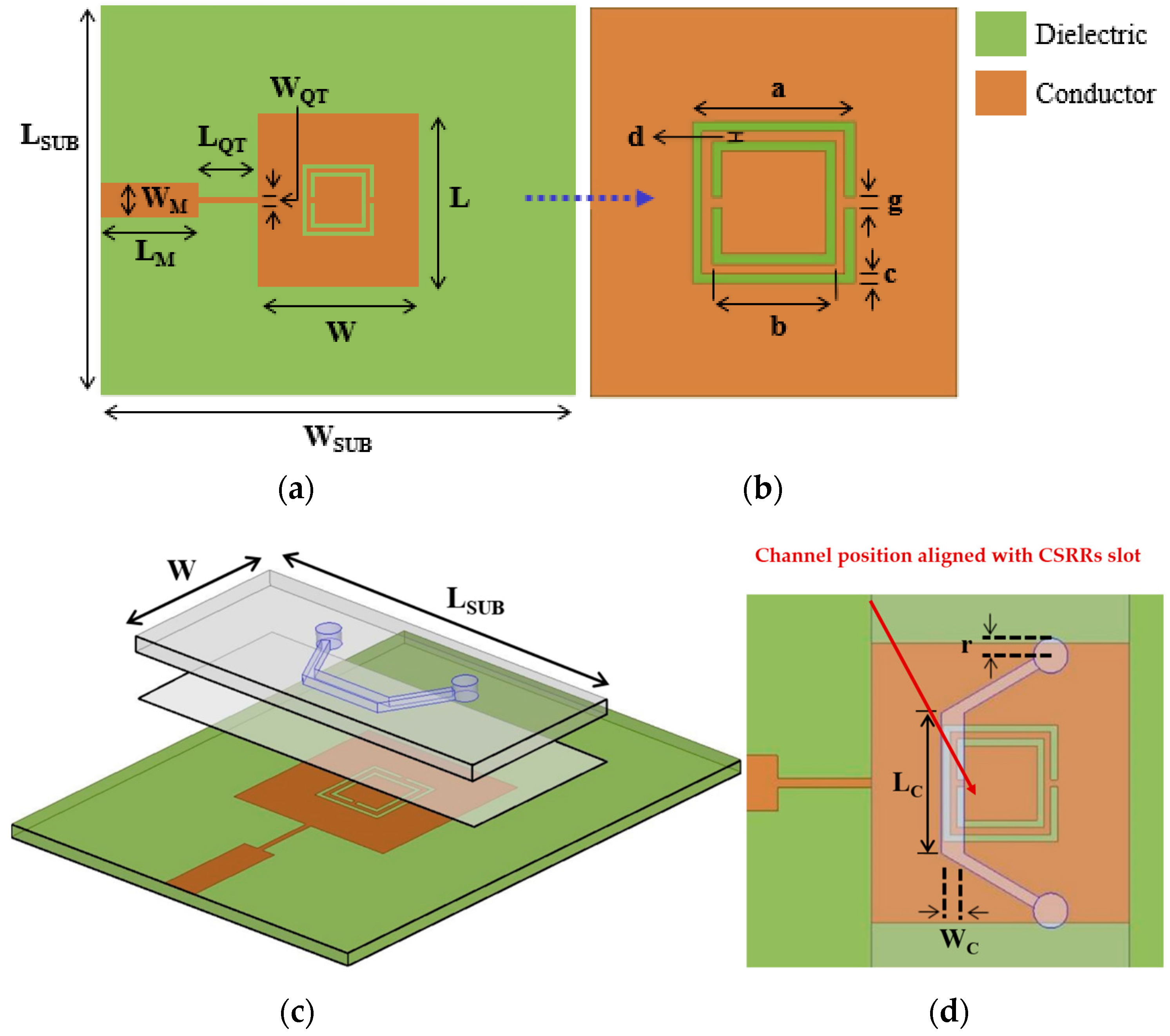
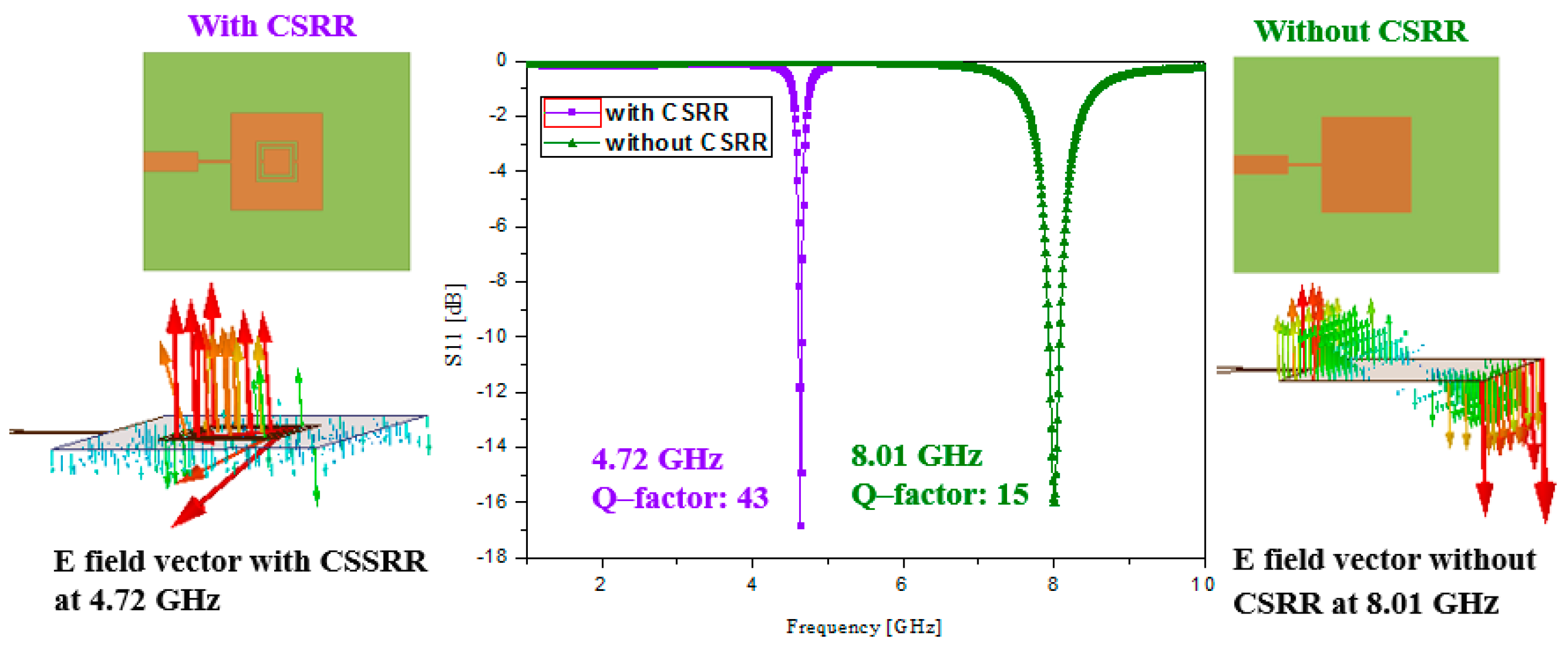

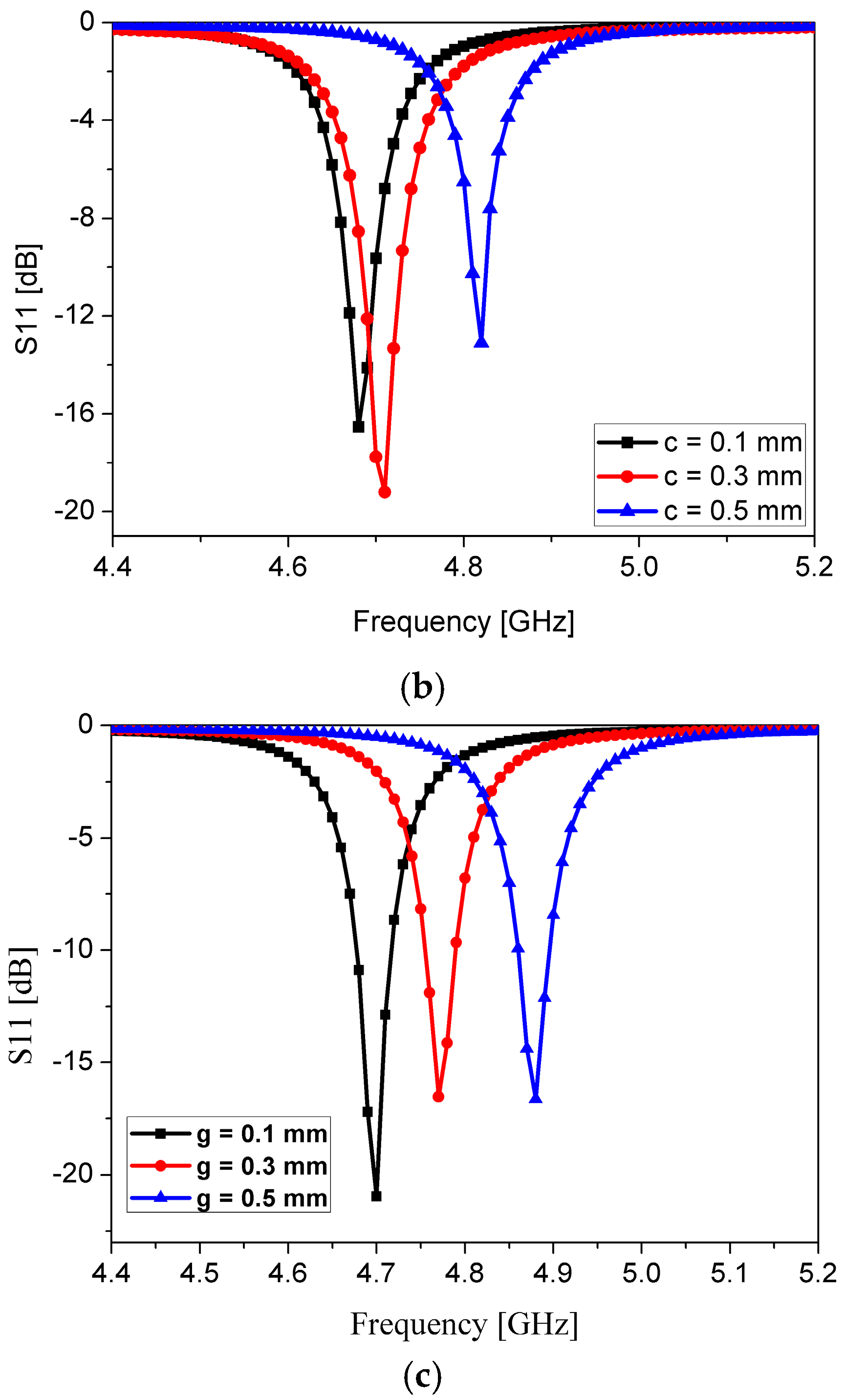

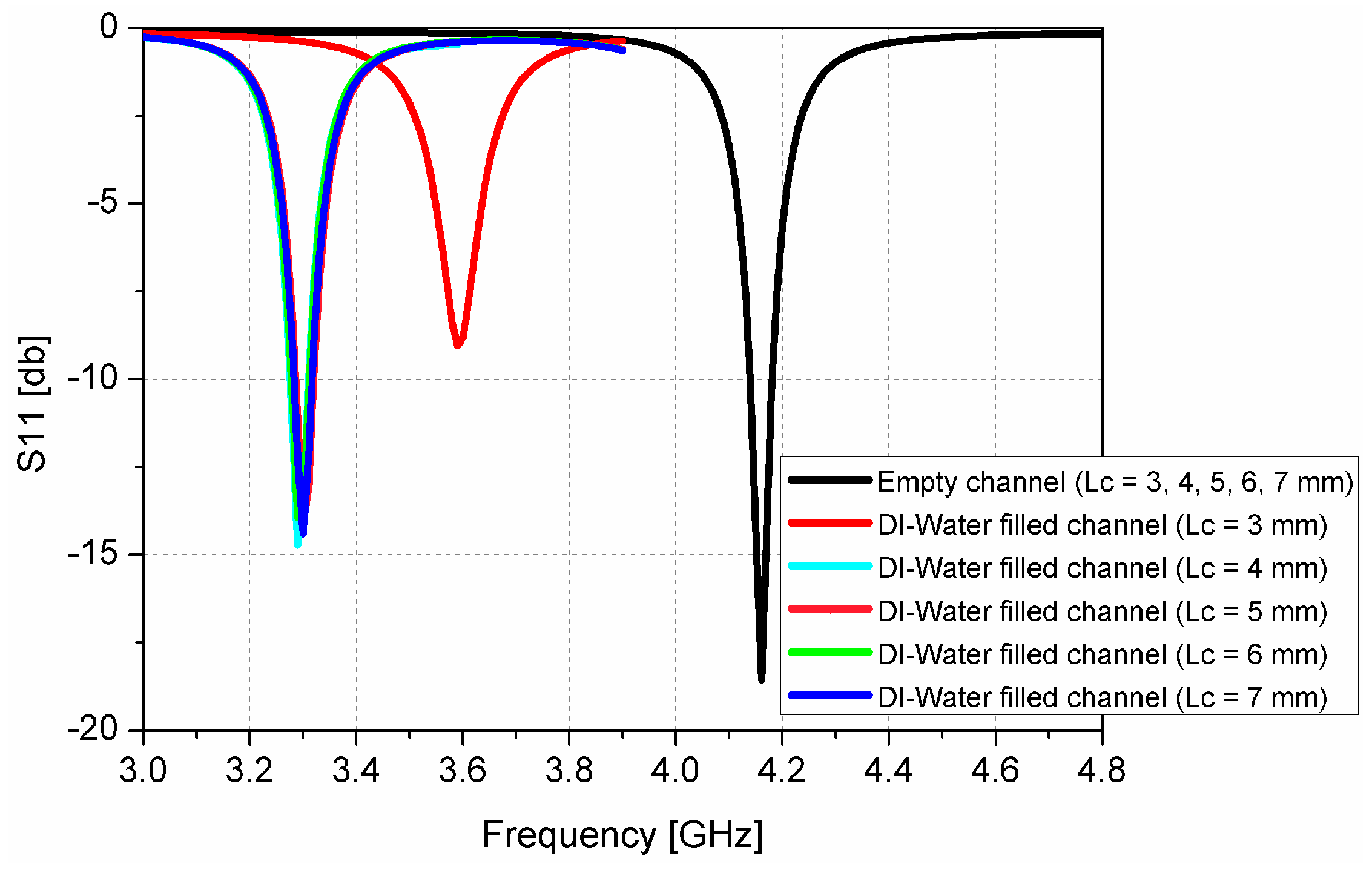

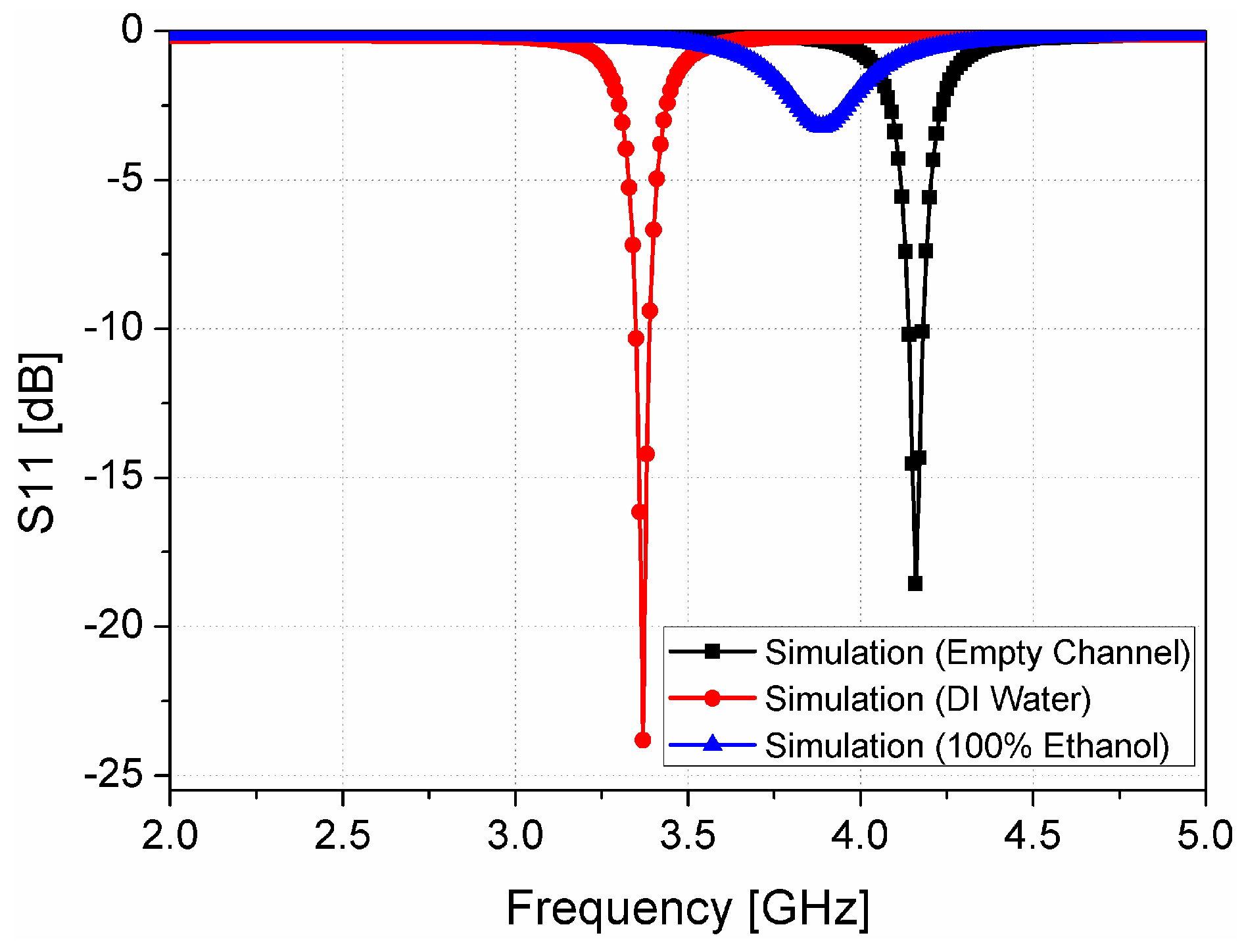
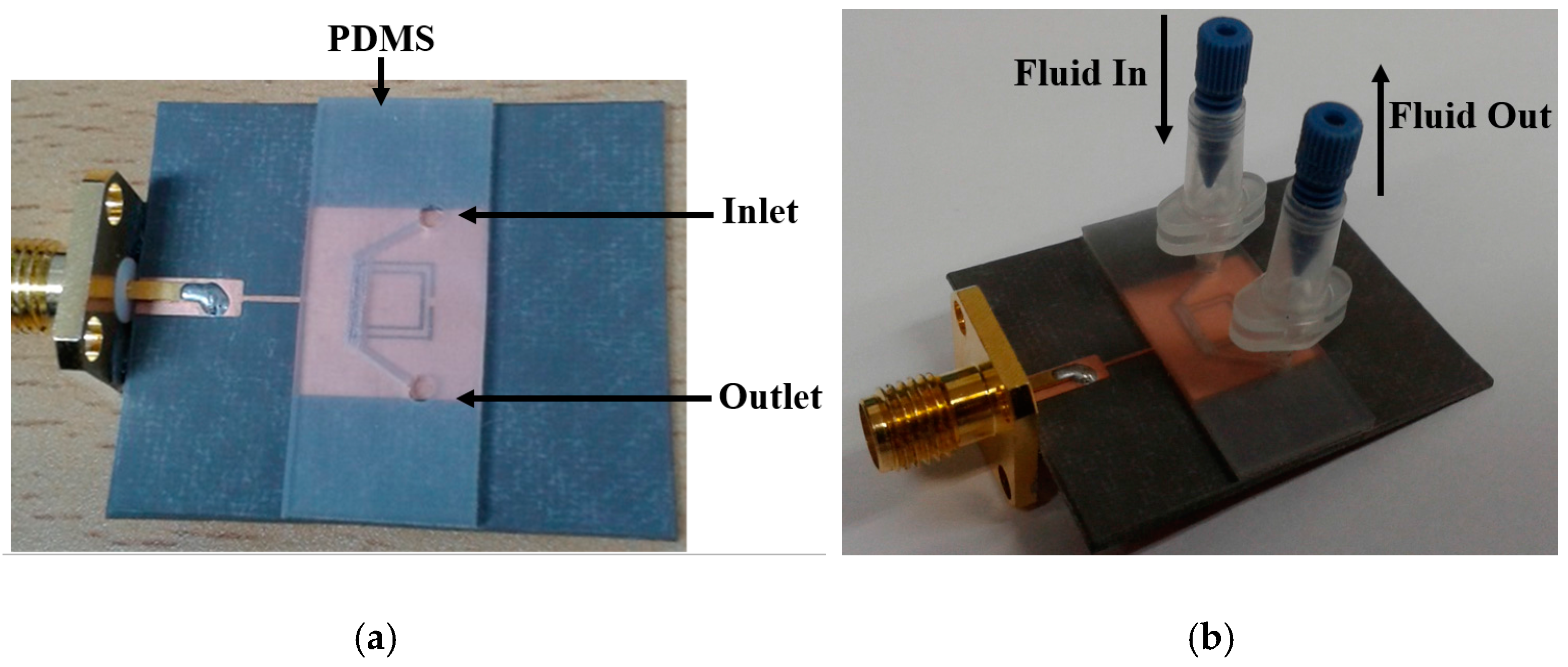
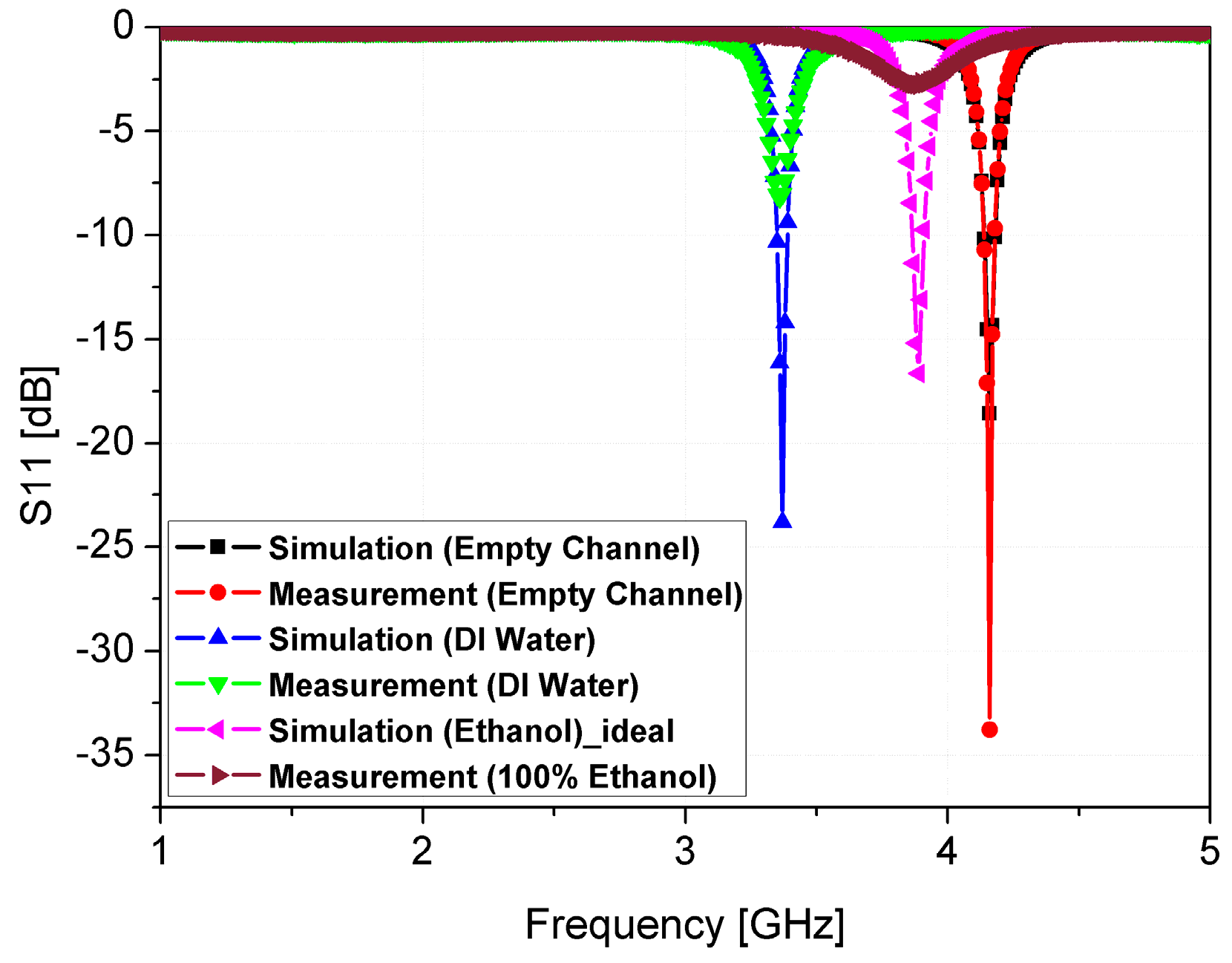
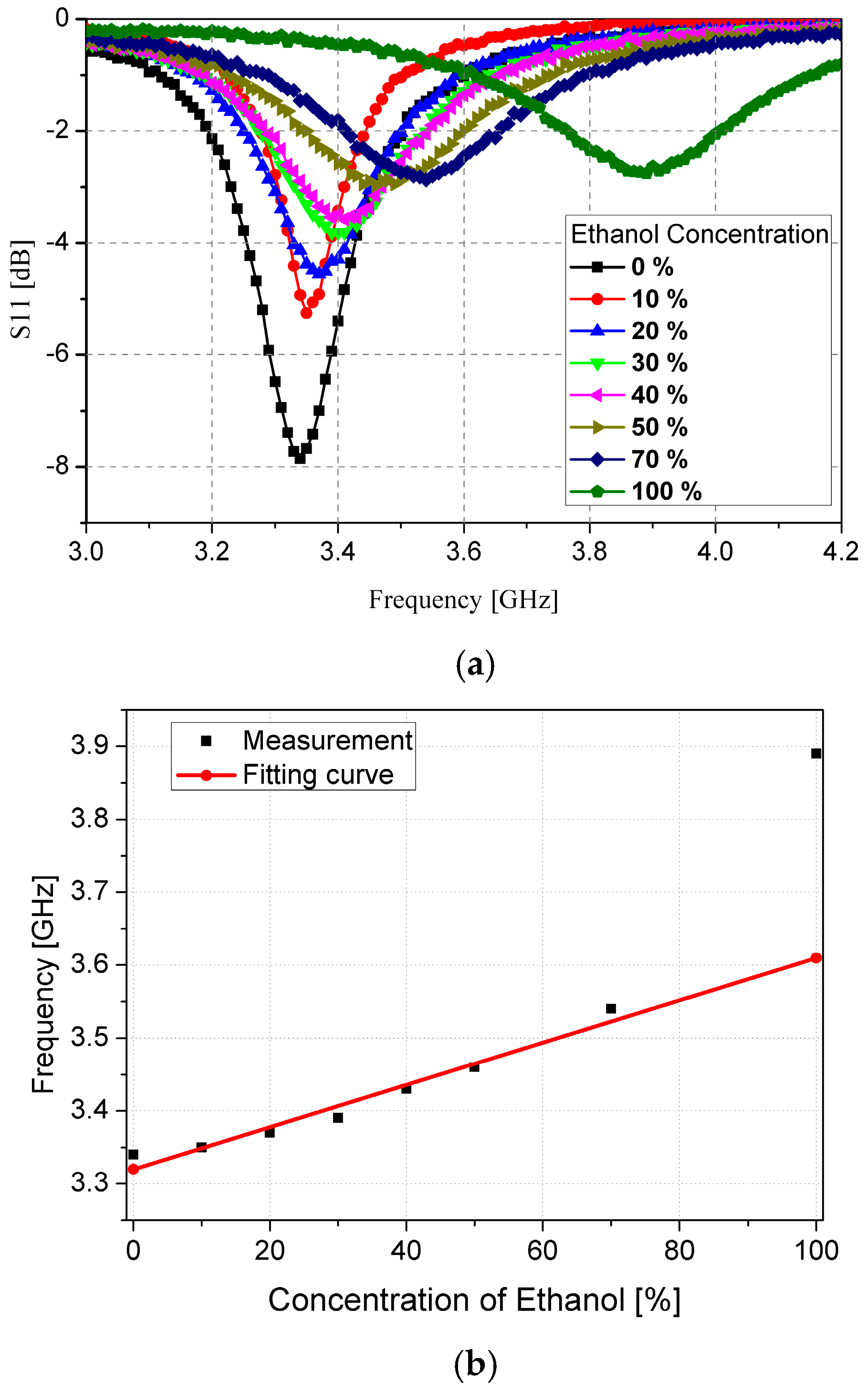
| Parameter | Value | Parameter | Value | Parameter | Value | Parameter | Value |
|---|---|---|---|---|---|---|---|
| L | 12 | LM | 6.75 | c | 0.3 | d | 0.3 |
| W | 11.3 | WM | 2.38 | g | 0.3 | r | 0.75 |
| LQT | 4.1 | a | 5 | LSUB | 27 | WSUB | 33 |
| WQT | 0.4 | b | 3.8 |
| References | Sensing Material | Frequency [GHz] | Frequency Shift (Δf) † [MHz] | Electrical Size †† | Sensitivity † (MHz/εr) | Volume [μL] |
|---|---|---|---|---|---|---|
| [16] | Ethanol liquid | 4.62–4.69 | 70 | 0.93λg × 0.81λg | 12.73 | 1 |
| [20] | Ethanol liquid | 4.23–4.48 | 250 | 1.26λg × 0.63λg | 45.45 | 5 |
| [21] | Amonia gas | 4.210–4.367 | 157 | 1.29λg × 1.29λg | N/A | N/A |
| [49] | Ethanol gas | 14.85–15.07 | 220 | 2.71λg × 1.35λg | 40 | N/A |
| This Work | Ethanol liquid | 3.89–4.16 | 270 | 0.63λg × 0.51λg | 49.1 | 3 |
| References | Sensing Materials | Contact | Fabrication Complexity | Sensitivity | Limit of Detection |
|---|---|---|---|---|---|
| [41] | Ethanol gas | contact | Complex | 31.4 † | 10 ppm @ 300 °C |
| [50] | Ethanol liquid | contact | Complex | 57.3 † | 100 ppm @ 400 °C |
| [51] | Ethanol vapor | contact | Complex | 4.6 † | 300 ppm @ 350 °C |
| [52] | Ethanol gas | contact | Complex | 24.5 † | 50 ppm @ 25 °C |
| [53] | Ethanol vapor | contact | Complex | 19.6 † | 10 ppm @ 220 °C |
| This Work | Ethanol liquid | Non-contact | Simple | 49.1 †† MHz/εr | 78,990 ppm |
© 2016 by the authors; licensee MDPI, Basel, Switzerland. This article is an open access article distributed under the terms and conditions of the Creative Commons Attribution (CC-BY) license (http://creativecommons.org/licenses/by/4.0/).
Share and Cite
Salim, A.; Lim, S. Complementary Split-Ring Resonator-Loaded Microfluidic Ethanol Chemical Sensor. Sensors 2016, 16, 1802. https://doi.org/10.3390/s16111802
Salim A, Lim S. Complementary Split-Ring Resonator-Loaded Microfluidic Ethanol Chemical Sensor. Sensors. 2016; 16(11):1802. https://doi.org/10.3390/s16111802
Chicago/Turabian StyleSalim, Ahmed, and Sungjoon Lim. 2016. "Complementary Split-Ring Resonator-Loaded Microfluidic Ethanol Chemical Sensor" Sensors 16, no. 11: 1802. https://doi.org/10.3390/s16111802






